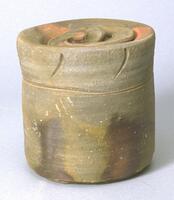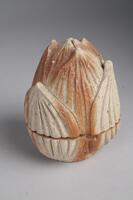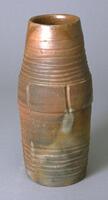10 UMMA Objects
10 UMMA Objects
![Flared base with rounded food storage bowl on top. The base is cut with evenly spaced rectangular holes. The lid is incised with a repeating herringbone, or dotted design. The know on the lid is the shape of a Buddhist canopy, or chattra.<br />
<br />
This is a dark blue-gray, high-fired stoneware lidded stem cup. The lid is crowned by a pearl-shaped knob, while both the inner and outer surfaces of lid have traces related to the attachment of the knob to the lid. A v-shaped pattern of engraved dots, made using a sixtooth comb, surrounds the central knob. The cup’s flange slopes inwards and has a sharp edge. The cup body has a horizontal gallery that holds the lid in place. The stem is perforated by rectangular openings, below which is a sharply protruding circular raised band. Traces of rotation and water smoothing are visible on the body and stem of the cup.
<p>[Korean Collection, University of Michigan Museum of Art (2017) p. 59]</p>
Flared base with rounded food storage bowl on top. The base is cut with evenly spaced rectangular holes. The lid is incised with a repeating herringbone, or dotted design. The know on the lid is the shape of a Buddhist canopy, or chattra.<br />
<br />
This is a dark blue-gray, high-fired stoneware lidded stem cup. The lid is crowned by a pearl-shaped knob, while both the inner and outer surfaces of lid have traces related to the attachment of the knob to the lid. A v-shaped pattern of engraved dots, made using a sixtooth comb, surrounds the central knob. The cup’s flange slopes inwards and has a sharp edge. The cup body has a horizontal gallery that holds the lid in place. The stem is perforated by rectangular openings, below which is a sharply protruding circular raised band. Traces of rotation and water smoothing are visible on the body and stem of the cup.
<p>[Korean Collection, University of Michigan Museum of Art (2017) p. 59]</p>](/media/W1siZiIsIjIwMjIvMDkvMjQvOTRoajlpcWRqbV9kZWZhdWx0LmpwZyJdLFsicCIsInRodW1iIiwiMjQweDIwMCJdXQ?sha=27b6314c0d4219a2)
Korean (Korean (culture or style))
Pedestal Bowl with Cover
5th century
Gift of Bruce and Inta Hasenkamp and Museum purchase made possible by Elder and Mrs. Sang-Yong Nam
2004/1.169A&B
![Flaring base with spherical food storage bowl on top. The base is cut with evenly spaced rectangular holes. The lid is incised with a repeating design.<br />
<br />
This is a grayish white, high-fired stoneware lidded stem cup. The lid features a button-shaped knob at the center, around which a thin circle is inscribed. Triangular line designs are contained within the circle, which is surrounded by a row of semicircles with dots inside. The single-tiered, perforated, trumpetshaped pedestal has three rectangular openings. The pedestal flares widely outwards towards its bottom, which has a horizontally spreading edge.
<p>[Korean Collection, University of Michigan Museum of Art (2017) p. 62]</p>
Flaring base with spherical food storage bowl on top. The base is cut with evenly spaced rectangular holes. The lid is incised with a repeating design.<br />
<br />
This is a grayish white, high-fired stoneware lidded stem cup. The lid features a button-shaped knob at the center, around which a thin circle is inscribed. Triangular line designs are contained within the circle, which is surrounded by a row of semicircles with dots inside. The single-tiered, perforated, trumpetshaped pedestal has three rectangular openings. The pedestal flares widely outwards towards its bottom, which has a horizontally spreading edge.
<p>[Korean Collection, University of Michigan Museum of Art (2017) p. 62]</p>](/media/W1siZiIsIjIwMjIvMDkvMjQvNTJoNTVsdnQ4bV9kZWZhdWx0LmpwZyJdLFsicCIsInRodW1iIiwiMjQweDIwMCJdXQ?sha=7994f7d61cf86021)
Korean (Korean (culture or style))
Pedestal Bowl with Cover
6th century
Gift of Bruce and Inta Hasenkamp and Museum purchase made possible by Elder and Mrs. Sang-Yong Nam
2004/1.189A&B
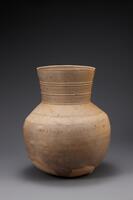
Korean (Korean (culture or style))
Round-Bottomed Jar with Straight Mouth
5th century
Gift of Bruce and Inta Hasenkamp and Museum purchase made possible by Elder and Mrs. Sang-Yong Nam
2004/1.172
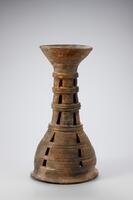
Korean (Korean (culture or style))
Tall Ceremonial Stand for Jar
5th century
Gift of Bruce and Inta Hasenkamp and Museum purchase made possible by Elder and Mrs. Sang-Yong Nam
2004/1.178
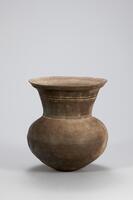
Korean (Korean (culture or style))
Round-Bottomed Jar with Wide Flared Mouth
400 – 599
Gift of Bruce and Inta Hasenkamp and Museum purchase made possible by Elder and Mrs. Sang-Yong Nam
2004/1.183

Korean (Korean (culture or style))
Flattened Bottle with Lion-head and Turle Lugs
900 – 1099
Gift of Bruce and Inta Hasenkamp and Museum purchase made possible by Elder and Mrs. Sang-Yong Nam
2004/1.210
![Earthenware stirrup cup with sgraffito design and celadon glaze. A chrysanthemum blossom decorates the tapered base of the cup, and widens into a large middle register with four stylized chrysanthemum medallions. The cup curves back inward toward the rim of the cup, decorated with a fret pattern just below.
<p>This is a conical stirrup cup designed to be inserted into a cup holder. It is a fine piece of celadon with the sudtle beauty of white inlaid decorations in match with the blue-gray body. Its entire outer wall is decorated with inlaid motifs of fret, chrysanthemums, scrolls and lotus petals.<br />
[<em>Korean Collection, University of Michigan Museum of Art</em> (2014) p. 128]</p>
Earthenware stirrup cup with sgraffito design and celadon glaze. A chrysanthemum blossom decorates the tapered base of the cup, and widens into a large middle register with four stylized chrysanthemum medallions. The cup curves back inward toward the rim of the cup, decorated with a fret pattern just below.
<p>This is a conical stirrup cup designed to be inserted into a cup holder. It is a fine piece of celadon with the sudtle beauty of white inlaid decorations in match with the blue-gray body. Its entire outer wall is decorated with inlaid motifs of fret, chrysanthemums, scrolls and lotus petals.<br />
[<em>Korean Collection, University of Michigan Museum of Art</em> (2014) p. 128]</p>](/media/W1siZiIsIjIwMjIvMDkvMjQvM2Rhbm9nMHdqdl9kZWZhdWx0LmpwZyJdLFsicCIsInRodW1iIiwiMjQweDIwMCJdXQ?sha=6cdf667dd9385763)
Korean (Korean (culture or style))
Stirrup cup with inlaid sgraffito chrysanthemum and scroll designs
13th century
Gift of Bruce and Inta Hasenkamp and Museum purchase made possible by Elder and Mrs. Sang-Yong Nam
2004/1.230
Loading…
